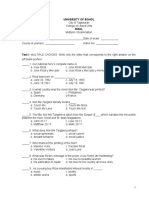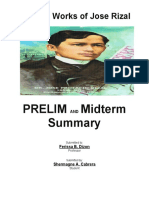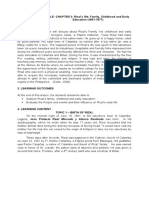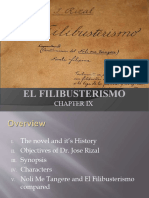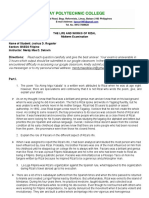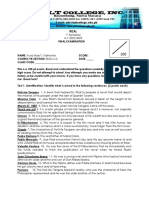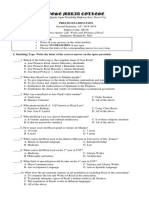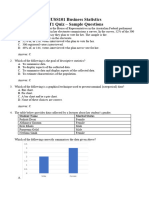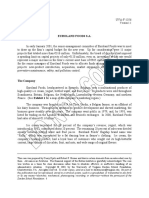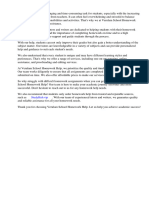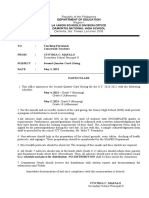0 ratings0% found this document useful (0 votes)
246 viewsRizal Life, Works and Writings
Rizal Life, Works and Writings
Uploaded by
Jay CruzRizal was a polymath who excelled in many fields including medicine, engineering, teaching and writing. He was born in Calamba, Philippines in 1861 and went on to study in Manila, Madrid and Paris where he obtained his medical degree. While abroad, he wrote his famous novels Noli Me Tangere and El Filibusterismo which criticized the Spanish colonial government and Catholic Church and their treatment of Filipinos. This led the Spanish authorities to accuse him of sedition. Rizal was eventually arrested and executed by firing squad in Manila in 1896 at the age of 35, making him a martyr in the Philippines' fight for independence from Spanish colonial rule.
Copyright:
© All Rights Reserved
Available Formats
Download as DOCX, PDF, TXT or read online from Scribd
Rizal Life, Works and Writings
Rizal Life, Works and Writings
Uploaded by
Jay Cruz0 ratings0% found this document useful (0 votes)
246 views8 pagesRizal was a polymath who excelled in many fields including medicine, engineering, teaching and writing. He was born in Calamba, Philippines in 1861 and went on to study in Manila, Madrid and Paris where he obtained his medical degree. While abroad, he wrote his famous novels Noli Me Tangere and El Filibusterismo which criticized the Spanish colonial government and Catholic Church and their treatment of Filipinos. This led the Spanish authorities to accuse him of sedition. Rizal was eventually arrested and executed by firing squad in Manila in 1896 at the age of 35, making him a martyr in the Philippines' fight for independence from Spanish colonial rule.
Original Title
RIZAL LIFE, WORKS AND WRITINGS
Copyright
© © All Rights Reserved
Available Formats
DOCX, PDF, TXT or read online from Scribd
Share this document
Did you find this document useful?
Is this content inappropriate?
Rizal was a polymath who excelled in many fields including medicine, engineering, teaching and writing. He was born in Calamba, Philippines in 1861 and went on to study in Manila, Madrid and Paris where he obtained his medical degree. While abroad, he wrote his famous novels Noli Me Tangere and El Filibusterismo which criticized the Spanish colonial government and Catholic Church and their treatment of Filipinos. This led the Spanish authorities to accuse him of sedition. Rizal was eventually arrested and executed by firing squad in Manila in 1896 at the age of 35, making him a martyr in the Philippines' fight for independence from Spanish colonial rule.
Copyright:
© All Rights Reserved
Available Formats
Download as DOCX, PDF, TXT or read online from Scribd
Download as docx, pdf, or txt
0 ratings0% found this document useful (0 votes)
246 views8 pagesRizal Life, Works and Writings
Rizal Life, Works and Writings
Uploaded by
Jay CruzRizal was a polymath who excelled in many fields including medicine, engineering, teaching and writing. He was born in Calamba, Philippines in 1861 and went on to study in Manila, Madrid and Paris where he obtained his medical degree. While abroad, he wrote his famous novels Noli Me Tangere and El Filibusterismo which criticized the Spanish colonial government and Catholic Church and their treatment of Filipinos. This led the Spanish authorities to accuse him of sedition. Rizal was eventually arrested and executed by firing squad in Manila in 1896 at the age of 35, making him a martyr in the Philippines' fight for independence from Spanish colonial rule.
Copyright:
© All Rights Reserved
Available Formats
Download as DOCX, PDF, TXT or read online from Scribd
Download as docx, pdf, or txt
You are on page 1of 8
RIZAL LIFE, WORKS AND WRITINGS
1. Rizal was a ______________.
a. Physician
b. Engineer
c. Philosopher
d. All of the above
2. Rizal epitomized the ideal Renaissance man – a person of broad intellectual and cultural
interests encompassing the full spectrum of available knowledge.
a. True
b. False
c. Subjective/Situational
d. Not applicable
3. Jose Rizal was born on _________________, between eleven and twelve o’clock midnight, a few
days before the full moon.
a. June 9, 1861
b. June 29, 1861
c. June 19, 1861
d. None of the above
4. His birth would have cost his mother’s life had she not vowed to the ______________ that
would take him on a pilgrimage of her shrine.
a. Mother of Perpetual Help
b. Our Lady of Fatima
c. Virgin of Antipolo
d. None of the above
5. Scenic _____________ is the picturesque town that gave birth to our hero. It is a town named
after a big native jar surrounded by a big hacienda which belonged to the Dominican Order,
which also owned almost all the lands around it.
a. Calamba
b. Paete
c. Calauan
d. None of the above
6. _____________ is the father of Jose Rizal.
a. Rafael Mercado Rizal
b. Francisco Mercado Rizal
c. Teodoro Mercado Rizal
d. None of the above
7. His great, great grandfather was a Christian Chinese named ____________, whom Rizal called a
“model of fathers.”
a. Dominador Laudico
b. Domingo Lamco
c. Eduardo Langco
d. None of the above
8. __________________, Rizal’s mother was born in Manila on November 8, 1826, a woman of
remarkable talent in mathematics, business and literature.
a. Teodora Alonzo
b. Teresita Alonzo
c. Thelma Alonzo
d. None of the above
9. Rizal inherited from his father a profound sense of dignity and self-respect, seriousness and self-
possession; and from his mother the temperament of the poet and dreamer and bravery for
sacrifice.
a. True
b. False
c. Subjective/Situational
d. Not applicable
10. ______________ is the hero’s only brother who joined General Aguinaldo’s revolutionary army,
where he rose to the rank of Major General.
a. Poncio
b. Pancho
c. Luciano
d. None of the above
11. When Rizal was 15 years old and was a student at Ateneo de Manila, he reminisced his beloved
town and wrote a poem, _______________________________.
a. Un Recuerdo A Mi Pueblo
b. My Childhood Memories
c. Sa Aking Kabata
d. None of the above
12. At the tender age of __________, Rizal learned the alphabet from his mother.
a. One
b. Two
c. Three
d. None of the above
13. Paciano, Jose’s brother became a trusted assistant of ______________in the fight for the
Filipinization of all parishes.
a. Father Burgos
b. Father Gomez
c. Father Zamora
d. None of the above
14. At the age of eight, he wrote in the poem _____________, as an appeal to his countrymen to
love their national language.
a. In Memory of my Town
b. Sa Aking Kabata
c. My Childhood Memories
d. None of the above
15. Jose went to Manila from Calamba to take the entrance examinations and enrolled in the
__________________, a college under the supervision of Spanish Jesuits.
a. College of San Juan de Letran
b. Ateneo Municipal
c. Universidad de Manila
d. None of the above
16. _____________ is a poem written by Rizal as an expression of good wishes which was full of
endearing filial affection on his mother’s birthday.
a. Sa Aking Kabata
b. In Memory of my Town
c. My First Inspiration
d. None of the above
17. _________________ was written by Rizal when he was eighteen years old at the University of
Santo Tomas in connection with a literary contest sponsored by Liceo Artistico – Literario, a
society of men interested in literature and arts.
a. My First Inspiration
b. To the Filipino Youth
c. In Memory of my Town
d. None of the above
18. ________________ is the art of carving, molding, welding or producing works of art in three
dimensions.
a. Painting
b. Sculpture
c. Architecture
d. None of the above
19. Rizal who was sixteen years old enrolled in the University of Sto. Tomas and took up
_______________before starting with his medical studies.
a. Biology
b. Philosophy and Letters
c. Engineering
d. None of the above
20. In his novel, ____________________ Rizal described how some Dominican professor insulted
Filipino students and mockingly called them “Indio.”
a. El Filibusterismo
b. Noli Me Tangere
c. Makamisa
d. None of the above
21. Rizal experience the “pleasure and pains of first love” in the person of _________________, who
was a boarder at La Concordia College, where his elder sisters were studying.
a. Leonor Rivera
b. Segundina Katigbak
c. Josephine Bracken
d. None of the above
22. Impelled by his desire to perfect himself and to become more useful to his people, Rizal left
home and country and went to Europe in order to educate himself.
a. True
b. False
c. Subjective/Situational
d. Not applicable
23. ______________ is a city of Catalina, Spain’s second largest city. Rizal was amused at the
famous street, Las Ramblas.
a. Madrid
b. Valencia
c. Barcelona
d. None of the above
24. In the Spanish capital, Rizal met and associated with other Filipino students who formed the
Spanish-Filipino Circle. The members of the association requested him to write a poem and this
was the ___________________.
a. Me Piden Versos
b. El Consejo delos Dioses
c. A La Juventud Filipina
d. None of the above
25. In the Madrigal Exposition of Fine Arts, Juan Luna’s painting, the ________________, was
awarded first prize and a gold medal.
a. Indios
b. Christian Virgin Exposed to the Populace
c. Spolarium
d. None of the above
26. Rizal went to Paris and Germany in order to specialize in ________________, a branch of
medical science dealing with the anatomy, functions, and diseases of the eye.
a. Ophthalmology
b. Optometry
c. Iridology
d. None of the above
27. Juan Luna painted a historical canvas, _______________ in which Rizal posed as Sikatuna and
Trinidad as Legaspi.
a. Indios
b. Christian Virgin Exposed to the Populace
c. Spolarium
d. None of the above
28. While in ___________, Rizal had the privilege to work in the clinic of a noted Polish
ophthalmologist, Dr. Javier Galezowsky. It is a city in Baden-Wurttemberg in West Germany,
famous for its old universities and beautiful sceneries in the countryside.
a. Heidelberg
b. Frankfurt
c. Berlin
d. None of the above
29. It was in Leipzig where he was inspired to translate Schiller’s __________________ from
German language to Tagalog version so that the Filipinos might understand the story of the
legendary Swiss patriot who championed its independence. The main character was forced by
the Austrian governor to shoot an apple off his son’s head with bow and arrow.
a. Mary Stuart
b. The Robbers
c. William Tell
d. None of the above
30. The reason why Rizal lived in Berlin was ______________________.
a. To gain further knowledge in ophthalmology
b. To observe the prevailing political, social and economic conditions
c. To finish writing his novel, Noli Me Tangere
d. All of the above
31. ____________________ means “do not touch me.” The book contains things of which no one
among ourselves has spoken up to the present; they are so delicate that can not be touched by
anybody.
a. A La Juventud Filipina
b. Noli Me Tangere
c. El Filibusterismo
d. None of the above
32. Upon the insistence of Rizal’s wealthy friend, _________________, who loaned P300 to Rizal,
Noli was finally printed in March, 1887.
a. Antonio Regidor
b. Prof. Ferdinand Blumentritt
c. Dr. Maximo Viola
d. None of the above
33. With adequate knowledge about the science of ophthalmology and his surgical skill acquired in
the best eye clinics in Europe, he successfully removed the ______________ from his mother’s
eyes.
a. Glaucoma
b. Cataract
c. Optic neuropathy
d. None of the above
34. Rizal was assigned a personal bodyguard named __________________ by the Governor-general
to protect him during the duration of his stay in the Philippines because he believed that Rizal’s
life might be in danger and because the friars were very powerful.
a. Don Jose Taviel de Andrade
b. Emilio Terrero
c. Pedro Payo
d. None of the above
35. The banning of the Noli only served to make it more popular because everybody would like to
have a copy and read it. In spite of the government prohibition, many Filipinos got hold of the
Noli which they read secretly.
a. True
b. False
c. Subjective/Situational
d. Not applicable
36. Rizal observed that there are few thieves in Japan. The houses remained open day and night and
other valuable articles are left on the table without being lost.
a. True
b. False
c. Subjective/Situational
d. Not applicable
37. Rizal’s romance with the Japanese lady named ______________ started in early sprig of March,
1888, when he entered a department store in Yokohama to buy something.
a. Akiko
b. Machiko
c. O-Sei-San
d. None of the above
38. Rizal said, “________________ is the land par excellence of freedom but only for the whites.”
a. Germany
b. England
c. America
d. None of the above
39. While in London, Rizal received some disturbing news from his country – the arbitrary arrest and
imprisonment of Laureano Viado, a Sto. Tomas medical student, who was found in possession of
__________________.
a. La Solidaridad
b. Noli Me Tangere
c. El Filibusterismo
d. None of the above
40. The need for an organ of the Propaganda to neutralize the false, malicious and defamatory
articles designed to injure the reputation of the Filipinos written by Spanish detractors and
mercenaries was evidently felt by the Filipinos in Spain that consequently led to the founding of
___________________.
a. Association Hispano-Filipina
b. La Solidaridad
c. La Vision de Fray Rodriguez
d. None of the above
41. Before leaving London, he carved several fine and realistic sculptural works governed by a great
and detailed attention to anatomical shapes and proportions such as _______________.
a. Prometheus Bound
b. The Triumph of Death over Life
c. The Triumph of Science over Death
d. All of the above
42. In Paris, the _______________ was founded simply to bring together young Filipinos in the
French capital in order that they could enjoy their stay in the city during the international
exposition.
a. Association Hispano-Filipina
b. Kidlat Club
c. Indios Bravos
d. None of the above
43. The saddest episode of Rizal’s life was the news of the impending marriage of ______________,
his sweetheart for eleven years to Mr. Kipping, an English engineer employed in the
construction of Manila-Dagupan railway.
a. Gertrude Beckett
b. Adelina Bousted
c. Leonor Rivera
d. None of the above
44. ______________, the capital of Spain, is one of the pleasant cities in the world because of its
people and culture. Upon arrival to this city, Rizal tried to exhaust all available legal means and
remedies to seek justice for his family and tenant farmers in Calamba, but justice on their side
seemed elusive.
a. Barcelona
b. Seville
c. Valencia
d. None of the above
45. With the help of his lawyer, __________________, they sought an audience with the minister of
the Colonies in order to present the various injustices committed by the Governor-General and
the Dominicans against the poor and helpless tenant-farmers of Calamba.
a. Marcelo H. del Pilar
b. Antonio Luna
c. Graciano Lopez Jaena
d. None of the above
46. While in Hongkong, Rizal wrote the __________________, an association of Filipinos for civic
and social activities until its printing in 1892.
a. Ang Karapatan ng mga Tao
b. Constitution and By-Laws of La Liga Filipina
c. Sa Mga Kababayan
d. None of the above
47. Four days after the founding of ____________________, Rizal was ordered arrested by
Governor-General Despujol allegedly for having found in his baggage, a few hours after his
arrival from Hongkong a bundle of leaflets entitled “Poor Friars” (Pobres Frailes).
a. Association Hispano-Filipina
b. Indios Bravos
c. La Liga Filipina
d. None of the above
48. One of the most significant events worth remembering in connection with Rizal’s life in Dapitan
was the coming into his life of _____________________, the adopted daughter of an American
engineer, George Taufer.
a. Leonor Rivera
b. Josephine Bracken
c. Gertrude Beckett
d. None of the above
49. Bonifacio and his Katipunan followers proclaimed defiance of the Spanish government by
tearing their cedula certificates during the famous historical _________________.
a. Cry of Katipunan
b. Cry of Dapitan
c. Cry of Balintawak
d. None of the above
50. ______________ was a novel that bore an irresistible urge to revolution, while promising
nothing from it.
a. El Filibusterismo
b. Noli Me Tangere
c. Huling Paalam
d. None of the above
You might also like
- Gulu SubmissionsDocument10 pagesGulu Submissionsjopiyo953No ratings yet
- The KEIRSEY Temperament SorterDocument14 pagesThe KEIRSEY Temperament SorterJay CruzNo ratings yet
- 2nd Prelim-Rizal With Key Answers FinalDocument5 pages2nd Prelim-Rizal With Key Answers FinalJezreel John Lacson Lapa100% (2)
- Mock Midterm Examination - Criminal Law 1Document2 pagesMock Midterm Examination - Criminal Law 1Jay Cruz100% (1)
- Loan Application FormDocument4 pagesLoan Application FormsimranNo ratings yet
- Rizal MidtermDocument4 pagesRizal MidtermRoland Aparece100% (2)
- Write The Letters Only of The Correct Answer in CAPITAL,: Test I. Multiple Choice (30 Points) DirectionsDocument4 pagesWrite The Letters Only of The Correct Answer in CAPITAL,: Test I. Multiple Choice (30 Points) DirectionsTRISH BOCANo ratings yet
- Rizal MidtermDocument4 pagesRizal MidtermIvy DiazNo ratings yet
- RIZAL Midterm Exam TodayDocument5 pagesRIZAL Midterm Exam TodayJanina Francisco100% (1)
- St. Mary's College of Catbalogan Catbalogan City: Midterm Examination in RizalDocument5 pagesSt. Mary's College of Catbalogan Catbalogan City: Midterm Examination in RizalBill Russell CecogoNo ratings yet
- Rizal Mock Test v.02Document6 pagesRizal Mock Test v.02Jerome CayabyabNo ratings yet
- Lineage, Life and Labors of José Rizal, Philippine PatriotFrom EverandLineage, Life and Labors of José Rizal, Philippine PatriotRating: 5 out of 5 stars5/5 (4)
- MIDTERM AnswersDocument5 pagesMIDTERM AnswersDonayre SevillaNo ratings yet
- Midterm Life and Works of RizalDocument51 pagesMidterm Life and Works of RizalTapia, DarleenNo ratings yet
- Rizal MidtermsDocument3 pagesRizal MidtermsAnne Besin100% (2)
- Dr. Jose Protacio Mercado Rizal Alonso Y RealondaDocument22 pagesDr. Jose Protacio Mercado Rizal Alonso Y RealondaKathrene Angel GumilaoNo ratings yet
- Sem FinalDocument4 pagesSem FinalJen JenNo ratings yet
- Rizal Fin 2Document2 pagesRizal Fin 2Mello Jane Garcia DedosinNo ratings yet
- Prelim Exam RizalDocument4 pagesPrelim Exam RizalCarrie SangcapNo ratings yet
- LO 2 LM02 - The Development of Filipino NationalismDocument21 pagesLO 2 LM02 - The Development of Filipino NationalismNathan CalmsNo ratings yet
- RIZAL MODULE 5 - Rizal's First Trip in Europe EACDocument17 pagesRIZAL MODULE 5 - Rizal's First Trip in Europe EACJ Y A J S VLOGS100% (1)
- Rizal PrelimDocument2 pagesRizal PrelimAnonymous SBT3XU6INo ratings yet
- Which of The Following Is NOT A Goal in The Teaching of The Life, Works, and Writings of Rizal in Colleges and Universities?Document4 pagesWhich of The Following Is NOT A Goal in The Teaching of The Life, Works, and Writings of Rizal in Colleges and Universities?Rudolph FelipeNo ratings yet
- MIDTERM EXAMINATION IN GE-9 RizalDocument5 pagesMIDTERM EXAMINATION IN GE-9 Rizalcesar pabilonaNo ratings yet
- Ebook PDF File of The Life and Works of Jose Rizal 1Document227 pagesEbook PDF File of The Life and Works of Jose Rizal 1Xedric Alvarez100% (2)
- Japanese Colonial Period QuizDocument4 pagesJapanese Colonial Period QuizJuancho OsorioNo ratings yet
- Life and Works of Rizal Midterm ReviewerDocument7 pagesLife and Works of Rizal Midterm ReviewerMargaret Joy SobredillaNo ratings yet
- Chapter 14-Life and Writings of RizalDocument2 pagesChapter 14-Life and Writings of RizalSteave Marville Pascual50% (2)
- Rizal Final ExamDocument1 pageRizal Final ExamBryan Catungal100% (5)
- TEST II: True or False (10pts.) DIRECTIONS: Write A If The Statement Is Correct and O If The Statement Is WrongDocument3 pagesTEST II: True or False (10pts.) DIRECTIONS: Write A If The Statement Is Correct and O If The Statement Is WrongTRISH BOCANo ratings yet
- Script in Reporting SampleDocument5 pagesScript in Reporting SampleJollina E. TanNo ratings yet
- PRELIM-EXAM - 2 1st-SEM-2020-21-RIZALDocument5 pagesPRELIM-EXAM - 2 1st-SEM-2020-21-RIZALJessaNo ratings yet
- Life and Works of Jose Rizal: Prelim MidtermDocument23 pagesLife and Works of Jose Rizal: Prelim MidtermKang ChulNo ratings yet
- CHAPTER 3. Rizal's Life - Family, Childhood and Early Education (1861-1877)Document12 pagesCHAPTER 3. Rizal's Life - Family, Childhood and Early Education (1861-1877)Erick LabradorNo ratings yet
- Rizal MidtermDocument5 pagesRizal MidtermAr SHNzNo ratings yet
- Rizal's Life Report by Group BDocument31 pagesRizal's Life Report by Group Bazor ahai100% (1)
- Writing of Noli Me TangereDocument22 pagesWriting of Noli Me TangereRonn SerranoNo ratings yet
- Module 8 RizalDocument7 pagesModule 8 RizalResty YbanezNo ratings yet
- Quiz 5 &6, Finals: Hindi Perfect Pero Sana MakatulongDocument486 pagesQuiz 5 &6, Finals: Hindi Perfect Pero Sana MakatulongAriam SorepsinNo ratings yet
- MIDTERM Test - Rizal's Life Works and Writings - QuizletDocument10 pagesMIDTERM Test - Rizal's Life Works and Writings - QuizletSherwin Buenavente SulitNo ratings yet
- Exam Prelim RizalDocument4 pagesExam Prelim RizalAnonymous yiqdcRgYdJ100% (3)
- Rizal-Noli and El FiliDocument50 pagesRizal-Noli and El FiliReign Khayrie Anga-anganNo ratings yet
- Midterm Exam Rizal Bsed FilipinoDocument3 pagesMidterm Exam Rizal Bsed FilipinoJoshua Dela Cruz Rogador100% (1)
- Midterm Exam: NAME - SECTIONDocument7 pagesMidterm Exam: NAME - SECTIONTanya Christa BandolaNo ratings yet
- Rizal Midt Erm ExamDocument3 pagesRizal Midt Erm Examfaye pantiNo ratings yet
- Final Exam in RizalDocument1 pageFinal Exam in Rizalmahal79No ratings yet
- Final Examination in Life and Works of RizalDocument3 pagesFinal Examination in Life and Works of RizalAllan DiazNo ratings yet
- Q&a RizalDocument7 pagesQ&a RizalGSCNo ratings yet
- Jose Rizal Chapter 2Document21 pagesJose Rizal Chapter 2Riecel Canson Makinano95% (37)
- Subject: The Life, Works, Writings of Jose Rizal Test I-Identification Directions: Write The Correct Answer in A Yellow Pad Paper. Avoid ErasuresDocument2 pagesSubject: The Life, Works, Writings of Jose Rizal Test I-Identification Directions: Write The Correct Answer in A Yellow Pad Paper. Avoid ErasuresLyra Mae De BotonNo ratings yet
- Reviewer On Our Hero's LifeDocument38 pagesReviewer On Our Hero's LifeSophia Joyce Diabordo SuganobNo ratings yet
- Final Exam RizalDocument4 pagesFinal Exam RizalAura mae valmonteNo ratings yet
- Infotech Institute College of Arts and Sciences Midterm Exam in Rizal Life, Works and WritingsDocument2 pagesInfotech Institute College of Arts and Sciences Midterm Exam in Rizal Life, Works and WritingsMichael Anthony EnajeNo ratings yet
- Module 3 One Past But Many HistoriesDocument42 pagesModule 3 One Past But Many HistoriesClint Escabal MosenabreNo ratings yet
- First Exam RizalDocument4 pagesFirst Exam Rizalrichard neriNo ratings yet
- Midterm RizalDocument2 pagesMidterm RizalCejoy Ann83% (12)
- PRELIMDocument3 pagesPRELIMShendy AcostaNo ratings yet
- Qualities of A HeroDocument21 pagesQualities of A HeroHonie PalabasanNo ratings yet
- Life and Works of RizalDocument8 pagesLife and Works of Rizaljac bnvstaNo ratings yet
- Rizal's Life: Rizal's Family, Childhood, & Early Education IIIDocument49 pagesRizal's Life: Rizal's Family, Childhood, & Early Education IIIJuvel Pascua100% (2)
- Reviewer Rizal PDFDocument38 pagesReviewer Rizal PDFBelle NegridoNo ratings yet
- Rizal and The La Solidaridad NewspaperDocument12 pagesRizal and The La Solidaridad Newspaperimeeramos3133% (3)
- Week 8 Studies in London, Paris Exposition, and Life in BelgiumDocument32 pagesWeek 8 Studies in London, Paris Exposition, and Life in BelgiumAGUSTIN VIVIAN MAENo ratings yet
- Activity 101 in RizalDocument6 pagesActivity 101 in RizalVee L.No ratings yet
- Legal Ethics Case DigestsDocument72 pagesLegal Ethics Case DigestsJay CruzNo ratings yet
- Navarro Basic Legal EthicsDocument10 pagesNavarro Basic Legal EthicsJay CruzNo ratings yet
- SECTION 3 - PRIVACY OF COMMUNICATION AND CORRESPONDENCE (Digests) PDFDocument11 pagesSECTION 3 - PRIVACY OF COMMUNICATION AND CORRESPONDENCE (Digests) PDFJay CruzNo ratings yet
- 254826-2020-De Zuzuarregui v. de ZuzuarreguiDocument7 pages254826-2020-De Zuzuarregui v. de ZuzuarreguiJay CruzNo ratings yet
- Philsat Practice BookletDocument120 pagesPhilsat Practice BookletJay CruzNo ratings yet
- Legal Ethics Third AssignmentDocument4 pagesLegal Ethics Third AssignmentJay CruzNo ratings yet
- Notes For Persons Regards To Article 2 of The Civil CodeDocument109 pagesNotes For Persons Regards To Article 2 of The Civil CodeJay CruzNo ratings yet
- Pag Ibig Foreclosed Properties 2016 07 14 Pubbid NCR No Discount PDFDocument17 pagesPag Ibig Foreclosed Properties 2016 07 14 Pubbid NCR No Discount PDFJay CruzNo ratings yet
- 2016 NAT Test Admin Guidelines For OrientationDocument73 pages2016 NAT Test Admin Guidelines For OrientationJay CruzNo ratings yet
- Prakriti PhysicsDocument9 pagesPrakriti Physicslolu pandeyNo ratings yet
- L200 Commercial Law 3Document4 pagesL200 Commercial Law 3sipho nkhataNo ratings yet
- Ever Be (C)Document2 pagesEver Be (C)Maddox HumphriesNo ratings yet
- Download Family Law for the Paralegal: Concepts and Applications 3rd Edition – Ebook PDF Version ebook All Chapters PDFDocument41 pagesDownload Family Law for the Paralegal: Concepts and Applications 3rd Edition – Ebook PDF Version ebook All Chapters PDFbaydararoth100% (3)
- Objectives of CRM: Relationship and The Main Objectives To Implement CRM in The Business Strategy AreDocument2 pagesObjectives of CRM: Relationship and The Main Objectives To Implement CRM in The Business Strategy Arebehappy_aklprasadNo ratings yet
- Gartner 2019 - Market Guide For Desktop As A ServiceDocument13 pagesGartner 2019 - Market Guide For Desktop As A ServiceJamey DAVIDSON100% (2)
- York County Court Schedule For March 22Document28 pagesYork County Court Schedule For March 22York Daily Record/Sunday NewsNo ratings yet
- VP General Manager Operations in Miami FT Lauderdale FL Resume Charles FloresDocument2 pagesVP General Manager Operations in Miami FT Lauderdale FL Resume Charles FloresCharlesFloresNo ratings yet
- Pied PiperDocument3 pagesPied PiperKwonyoongmaoNo ratings yet
- Be Form 3 - Resource Mobilization FormDocument3 pagesBe Form 3 - Resource Mobilization FormBhasy SenyelNo ratings yet
- Sim 160 SGDocument78 pagesSim 160 SGSheik Mohamed ImranNo ratings yet
- Limbona v. Mangelin, G.R. No. 80391, 28 February 1989Document2 pagesLimbona v. Mangelin, G.R. No. 80391, 28 February 1989Margo GreenNo ratings yet
- Tofi Flash 1Document2 pagesTofi Flash 1Chantal PascualNo ratings yet
- BUSS101 AT1 Quiz - SampleDocument6 pagesBUSS101 AT1 Quiz - Sampleshumhari46No ratings yet
- Thang Resume-EnglishDocument3 pagesThang Resume-EnglishAnh ThuNo ratings yet
- 10000019145Document14 pages10000019145Chapter 11 DocketsNo ratings yet
- Euroland Foods SA PDFDocument12 pagesEuroland Foods SA PDFPutu Aditya Pratama0% (1)
- Primary Make and Do Wheres Wally 30th CelebrationsDocument7 pagesPrimary Make and Do Wheres Wally 30th CelebrationsFelipeNo ratings yet
- Digipplus Services Pitch by Vinay Ostwal As A Freelancer WorkDocument4 pagesDigipplus Services Pitch by Vinay Ostwal As A Freelancer Workvinay ostwalNo ratings yet
- WDSF Open Under 21 LatinDocument12 pagesWDSF Open Under 21 Latinalexey73 0No ratings yet
- 1-Getting StartedDocument55 pages1-Getting StartedsoniarpbNo ratings yet
- Verulam School HomeworkDocument8 pagesVerulam School Homeworkgijaomtif100% (1)
- Fides Et RatioDocument3 pagesFides Et RatioRoderick kasoziNo ratings yet
- ADMINISTRATIVE LAW Digests CompleteDocument94 pagesADMINISTRATIVE LAW Digests Completenikol crisang50% (4)
- Eo VawcDocument1 pageEo VawcJolina Magpali TangalinNo ratings yet
- Border Aesthetics and Cultural DistancingDocument22 pagesBorder Aesthetics and Cultural DistancingGhali AchenNo ratings yet
- LM Format Nilai Rapor Semester Ganjil 2023-2024Document42 pagesLM Format Nilai Rapor Semester Ganjil 2023-2024achmad fatoniNo ratings yet
- Memo Card DayDocument9 pagesMemo Card DayrosalieNo ratings yet





